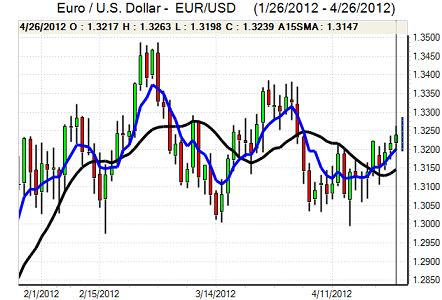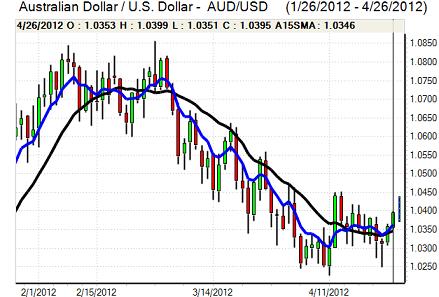EUR/USD
After challenging higher during the early European session on Thursday, the Euro was unable to break key resistance levels and drifted weaker, although ranges remained relatively narrow. There was a sharper than expected decline in Italian business confidence which dipped to the lowest level in over two years while the Euro-zone business confidence index also fell sharply for April.
There were persistent concerns surrounding peripheral economies which curbed Euro support. There was more positive news during the New York session with reports that the Dutch caretaker government was close to agreeing a 2013 budget.
The latest US jobless claims data was again weaker than expected with initial claims at 388,000 in the latest week from 389,000 the previous week, maintaining the significant deterioration seen during April. In contrast, the pending home sales data was stronger than expected with a 4.1% March increase following a 0.4% gain previously. The data will not resolve underlying uncertainties surrounding the economy or Federal Reserve policies. The dollar was still unsettled by the generally dovish Fed tone from Wednesday.
The latest data indicated that the cost of dollar borrowing had declined to nine-month lows which suggested that any dollar shortage had eased which will lessen the potential for sharp gains.
The Euro found support in the 1.32 region before moving back towards the 1.3250 area as the dollar remained generally on the defensive. The Euro was subjected to renewed selling pressure late in the US session as Standard & Poor’s cut Spain’s credit rating by a further two notches to BBB+ which also triggered some fresh unease over the Friday Italian debt auctions. The Euro found support above the 1.3170 region against the US dollar.

Source: VantagePoint Intermarket Analysis Software
Call now and you will be provided with FREE recent forecasts
that are up to 86% accurate* 800-732-5407
If you would rather have the recent forecasts sent to you, please go here
Yen
The dollar was unable to make any headway in European trading on Thursday and dipped sharply to lows near 80.70 as the yen gained ground on the crosses.
There were further uncertainties surrounding the Bank of Japan policies ahead if Friday’s policy meeting. The government pushed for further monetary easing, but there were also reports from sources that the central bank would resist major new measures.
Underlying risk appetite held firm as equities rallied and this dampened immediate yen demand.
The Bank of Japan announced a further expansion of JPY10trn in the asset-purchase programme to JPY40trn. There was also a JPY5trn cut in a domestic credit-purchase fund which caused some initial confusion on the headline announcement and triggered high yen volatility. The dollar pushed to highs around 81.40, but it was unable to sustain the gains and retreated back to below 81. The Japanese data was mixed with a stronger than expected increase in retail sales while the industrial production rebound was held to 1.0% for April.
Sterling
Sterling hit resistance close to 1.62 against the dollar on Thursday and initially edged lower from a 7-month peak.
The latest BBA mortgage approvals data recorded a decline to 10-month lows which reinforced concerns surrounding the housing sector. The latest CBI retail sales survey weakened to -6 for April from zero the previous month, but companies were notably more optimistic surrounding the May outlook which provided some relief.
MPC member Weale stated that the case for quantitative easing had been increased by the GDP data and negative media headlines surrounding the outlook increased.
There was still evidence of defensive inflows into the UK currency as uncertainties surrounding the Euro-zone economic outlook persisted. In this context, the trade-weighted index also hit a fresh 30-month high as the Euro retreated back towards 0.8150.
Swiss franc
Although the dollar briefly recovering back to the 0.91 level against the franc on Thursday, it was unable to sustain the recovery as the US currency remained generally on the defensive. The Euro was able to make a marginal advance against the Swiss currency before slipping again.
The economic ministry warned that that the franc was liable to trade near the 1.20 for some while yet, maintaining pressure on the National Bank to curb currency gains. There was further speculation over capital inflows into Swiss assets following Spain’s credit-rating downgrade.

Source: VantagePoint Intermarket Analysis Software
Call now and you will be provided with FREE recent forecasts
that are up to 86% accurate* 800-732-5407
If you would rather have the recent forecasts sent to you, please go here
Australian dollar
The Australian dollar found solid support on dips during Thursday and pushed to highs near the 1.04 level against the US currency. There was again a firmer tone to risk appetite as equity markets rallied and the US currency remained generally out of favour.
Risk appetite was hampered by the Spanish downgrade which also curbed immediate Australian dollar demand and there was further speculation over an interest rate cut at next week’s meeting. The Australian dollar weakened towards 1.0350, but losses were contained.



